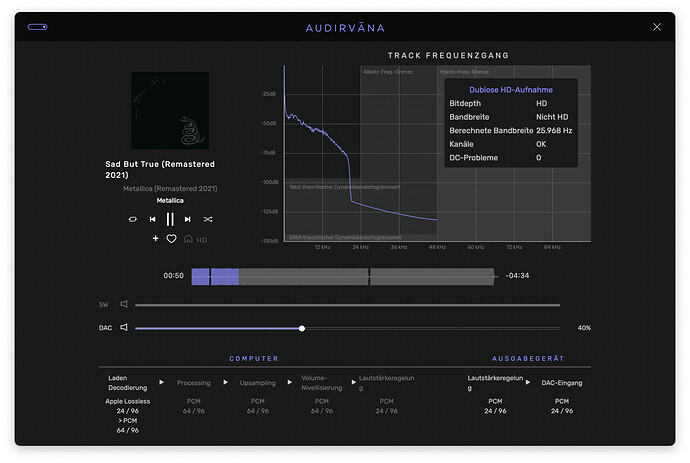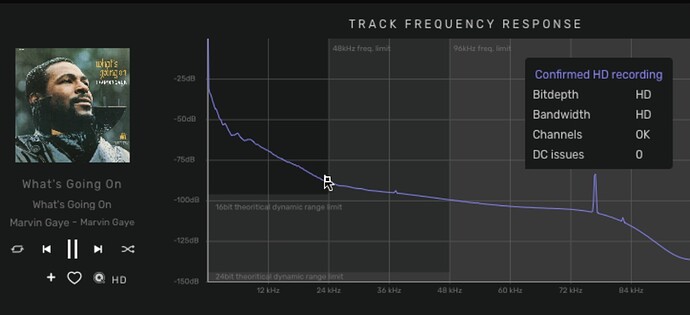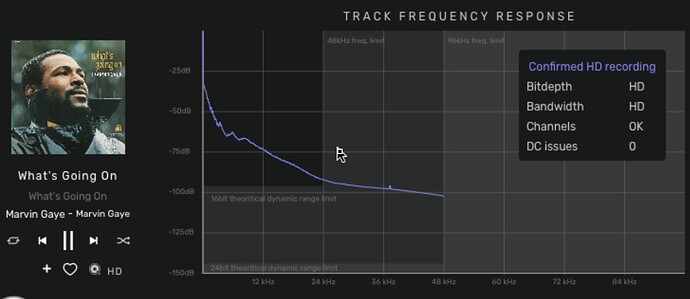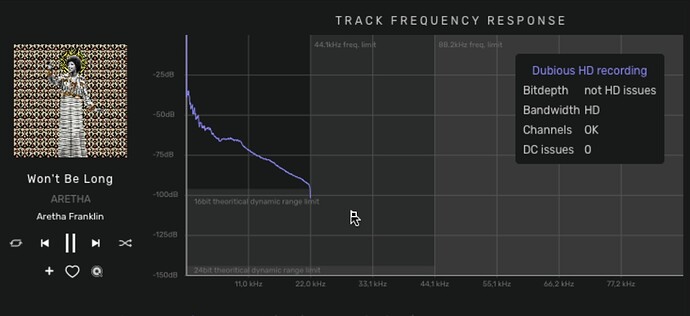Not much there above 22kHz or am I misinterpreting the graph?
The file is technically a HiRes. The bit depth/resolution is higher than 16/44.1.
Whether it is worth it for the content to sell this as HiRes is another question. There’s nothing that doesn’t fit in 16/44.1.
It may still be that the remaster sounds better.
I would bet on a 16/44.1 recording upsampled to 24/96.
I was curious how quickly the signal drops around around 48khz. But there is no filtering. It just stops.
If I take the first 192khz file from Qobuz, it seems like an incorrect rendering with the 96khz version. But the 44.1 also suddenly stops. The perfect brickwall filter?
From 192khz to 96 to 44.1.
16/44.1 looks different from the other two. At each resolution, the graph gives a different representation. The FFT is different. The higher the resolution file, the less ‘resolution’ in the graph. That makes it difficult to see what’s different in the audible spectrum with different versions of the same track.
Next:
What I expect as a real HiRes recording of a piano. According to the analyzer not HD because in this piece there is nothing above 12.5khz.
Why should the HiRes sound better than the Redbook?
It sounds better, because the higher the Hi Res, lesser upsampling is required from the chip of the DAC.
That’s very simplistic view and it’s not true. It should sound better because there is more information as well as the time resolution is higher. Whether it does indeed sound better, that’s a whole different question.
What you say is true in theory. In practice, if the were no technical reasons for that, the human ear will barely hear or won’t be able to hear at all the additional information that is included in the Hi Res file.
The time resolution is more important than the frequency response. Humans are very sensitive to the timing of the sounds, that’s how we make up where the sound is coming from. In theory you need a 192KHz sampling to match the timing resolution capabilities of the human auditory system.
After thinking about it, I should remind you that when you listen to your playback, you don’t hear the digital rate of the sampling, but to a continuous analogue sound.
It’s interesting to know what is Jacobs opinion.
I think you can clearly see with Aretha and Metallica that this probably wasn’t a HiRes recording. If it sounds better in HiRes then it’s likely that the upsampling at the remaster studio is better than the DAC at home can do. If you could use the same settings with HQplayer, it probably sounds the same. So here I agree with Doudou.
This is separate from the real HiRes recordings.
I have about the same opinion about HiRes as MQA. I have no problem with it being a better format in theory. It’s just that most of what’s for sale is nonsense.
The advantage is that the record labels can sell the same albums again for more money. Most consumers are happy because it sounds better. And the hardware manufacturers are also fine with it because they can release the same models that support even higher sample rates on the input. The DAC chip was already upsampling, nothing changes there.
I have to read about timing resolution again, or not and just listen to music.
If I recall correctly, RedBook’s timing resolution isn’t as bad as marketing would have us believe.
HQPlayer does even better than the Hi Res PCM files of recordings like these, because it can upsample to DSD at the rate that is supported by the DAC. The result is a sound with a sonic depth and sonic textures that are not audible with the PCM tracks.
We’re exploring the realms of theoretical limits.
So: Hardly anyone hears up to 20khz, because of the analog filtering it is better to increase the sampling frequency in the ADC and DAC. Better reconstruction filter sound better.
There is little to argue against.
Thank you for posting.
I knew that the reason for which 44.1 KHz are not sufficient were not acrostical but technical. Now I understand them better.
Apart from the discussion whether HiRes is necessary. This question is about whether the content of this file can be called HiRes? You can still see the brickwall filter around 20khz. That was the old mastering/recording. Then you can re-release it in HiRes, but that doesn’t change the source file.
Why would this file, when played on a good DAC, sound better than the original file. It’s the same content in more bits.
It can really be a remaster. Whether it sounds better is a question of taste.
If you have the original version I wouldn’t invest in the remaster. Still, if you’re purchasing it as only copy, it makes sense to go for the remaster. Still, only if it doesn’t cost more or you can really tell the difference.
Coming to conclusion that something is not hi-res just because it cuts of at 20K is also confusing. Hope they do a deeper analysis than that.
Again, I have nothing against formats. They all have their pros and cons. It’s about the music.
And it doesn’t make sense to say on a HiRes audio player forum that MP3 is good enough.  (I could make it a day job trolling every forum with arguments against the hobby.)
(I could make it a day job trolling every forum with arguments against the hobby.)
But it is interesting whether the average consumer or the enthusiast gets what he expects when he spends his money.
Analyzing afterwards what the source of a file has been is very difficult because you are looking at a new source. There is no historical information in a waveform. And also with MQA a blue light has no meaning which master is used.
The piano track has no energy higher in the spectrum, but that is simply because it is not in the lower octaves of the piano.
It’s great that ircam is researching this.
https://m.facebook.com/story.php?story_fbid=4327198273970374&id=287640054592903&m_entstream_source=timeline&tn=%2As%2As-R








